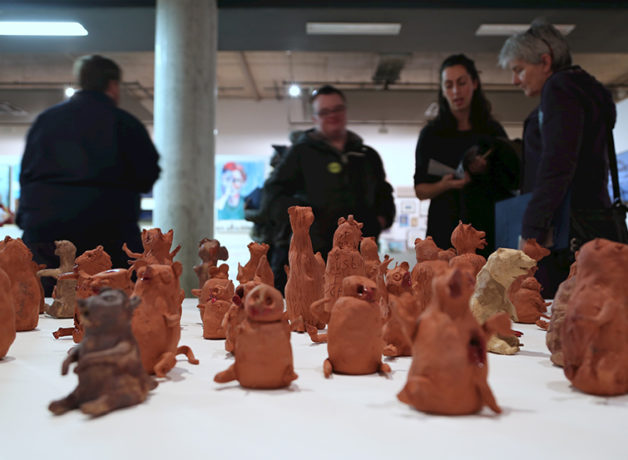We caught up with HOME’s curator Bren O’Callaghan to find out about the story behind the Manchester Open – HOME’s most successful exhibition ever.
When did you first have the idea for the Manchester Open?
It’s been gestating for a number of years as I tried to consider how to create more presentation opportunities for the multiple artist enquiries we receive on a regular basis. HOME has a limited amount of exhibition slots each year due to restricted budgets and the scale of changeovers for a gallery of our size. Also, not all artists have large bodies of work they wish to show, with many simply wanting to share their latest project, such as a painting series, film or live performance. As a curator my interests lie in championing those who may be overlooked or actively sidelined by formal routes of validation, so instead of only following those who grab headlines or are channelled through the top art schools, I’m far more interested in the strength of an idea and execution, than any perceived pedigree or stamp of approval. Finally the time felt right to explore the notion of introducing an open submission group exhibition, for all ages, with as few restrictions as possible. I had no idea if it would work or not…
What was the initial reaction to the idea?
Hugely favourable, although there can be hesitancy amongst professional artists, some of whom preferred not to submit alongside newcomers, as they understandably have spent a lot of time and effort studying, refining their craft and in most cases making great personal sacrifice to pursue their chosen career. But I stand by my belief that art and creative practice doesn’t need to pit amateur against professional, nor experience versus naivety. Art is for all, it is not to be rationed or earned, creative expression is a human right and success should not solely be judged against the financial value of any given result. Rather, a spectrum of achievement should reflect the multifarious reasons that we use and turn to art to explore our lived experience and as a powerful tool for radical self-expression, empathy and connection with others.
How did you set about making the idea a reality?
Lots of research and planning, with plenty of blind and wilful optimism! We identified and spoke with as many region-wide open exhibitions across the North West, of which there are around a dozen within Greater Manchester, albeit limited to much more restricted geographical catchment zones for entries, such as The Harris in Preston, or The Grundy in Blackpool. We also spoke to colleagues at The Royal Academy in London, who host the world’s largest and longest-running open exhibition. But there was definitely a tipping point at which the scale of our ambition started to feel a little terrifying, and so we made a call to crack on and not scare ourselves any further with tales of complex administrative procedures by rolling up our sleeves and getting on with it.
What was the biggest challenge?
That was definitely the open online submission portal. We have an excellent team of staff, from IT to communications, marketing and outreach, and it took a village to raise the precocious and attention-hungry child that was the online means for anyone to submit their work remotely, at no cost other than a suggestion donation, regardless of medium. We weren’t aiming for perfection, and we learnt a lot along the way that we intend to improve across future editions, but we did an incredible job with the help of our go-to web designers at Manchester agency OH Digital. The result was a clean, functional interface that also allowed us to review submissions as they came in, plus the means for our judging panel to review and assess each entry, while also gathering key information to help our Technical team with planning layout and install. We did a brilliant job, and there is no way I’m going to pretend we didn’t!
What was the most surprising thing?
The quality of the entries. I had hoped, and stated publicly, that I believed that vast reserves of untapped talent existed across the region, and that we had barely begun to scrape the surface. But when the entries began to flood in, I was blown away by the range and level of ability. Of particular significance were the many local groups that Anne Louise Kershaw, our Producer for Community and Outreach, was able to identify and support who might otherwise have hesitated from sending in work. From nursing homes to rehabilitation units, refugee groups and support networks, artist studios and hobbyists, to those using art as a tool to navigate complex emotional needs, the diversity and talent hiding in plain sight has been astounding.
How did you feel on opening night when the queues stretched out of the door?
Pride. Teary-eyed, heart swelling, showbiz-mom, glory-by-proxy, ruddy-cheeked pride. I believed in our creative communities, and they believed in each other. Never again can any naysayers suggest that there isn’t a hunger for or need to support local creative practice. Following the astonishing scenes of 2,000 queuing around the block on the opening night, over 32,000 visitors followed in their footsteps, and it is now officially our most popular exhibition since opening HOME – more than any celebrity or international artist who previously might have been thought to be the best route for attracting visitors to our gallery exhibitions.
Do you have any favourite pieces?
I try to remain as objective as possible, and I like many different works for different reasons, but I did purchase a small aquatint of the modernist, concrete architecture of Barton Aerodrome, by artist Jo Beggs of Hot Bed Press in Salford.

Barton Aerodrome by Jo Beggs
Do you have any tips for artists hoping to see their work in a gallery one day?
Challenge yourself to be honest in exploring your reasons for making art. Is it for recognition, and validation? Is it in the hope of making lots of money? Is it because you feel you have something to say via visual, aural, sensory or abstract means that you hope will chime with others? Or is it because despite more financially lucrative routes there remains an internal, compulsive drive to make, to explore, to dream? If it feels like anything less than a curse, it’s probably the wrong reason to be in this game. For those of us spellbound, we will keep upon our magical quest until we find what we are looking for. Answers on a postcard, please. No really, please!


